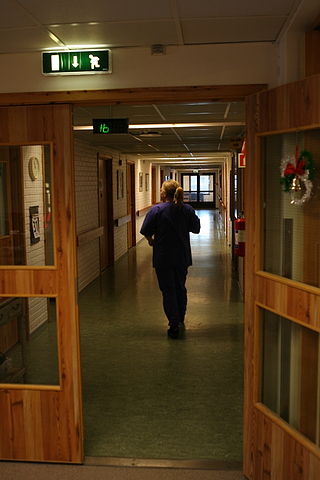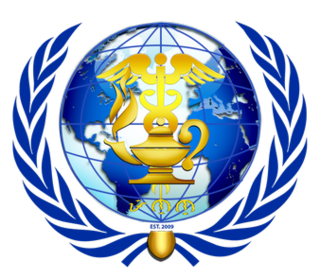
SUNY Downstate Medical Center is a public medical school and hospital in Brooklyn, New York. It is the southernmost member of the State University of New York (SUNY) system and the only academic medical center for health education, research, and patient care serving Brooklyn's 2.5 million residents. As of Fall 2018, it had a total student body of 1,846 and approximately 8,000 faculty and staff.

After the Bolivarian Revolution, extensive inoculation programs and the availability of low- or no-cost health care provided by the Venezuelan Institute of Social Security made Venezuela's health care infrastructure one of the more advanced in Latin America.

amfAR, the Foundation for AIDS Research, known until 2005 as the American Foundation for AIDS Research, is an international nonprofit organization dedicated to the support of AIDS research, HIV prevention, treatment education, and the advocacy of AIDS-related public policy.

A nursing shortage occurs when the demand for nursing professionals, such as Registered Nurses (RNs), exceeds the supply locally—within a healthcare facility—nationally or globally. It can be measured, for instance, when the nurse-to-patient ratio, the nurse-to-population ratio, the number of job openings necessitates a higher number of nurses than currently available, or the current number of nurses is above a certain age where retirement becomes an option and plays a factor in staffing making the workforce in a higher need of nurses. The nursing shortage is global according to 2022 World Health Organization fact sheet.
Filipino Austrians are Austrians of full or partial Filipino descent and are part of the so-called Overseas Filipinos. When excluding Afghan, Iraqi and Syrian refugees, Filipinos make up the fourth largest group of Asians within Austria, behind Iranian, Chinese and Indian people and form the largest Southeast-Asian community in the country. The majority of them live in Vienna, the capital of Austria.
Health in Afghanistan remains poor but steadily improving. It has been negatively affected by the nation's environmental issues and the decades of war since 1978. The Ministry of Public Health (MoPH) oversees all matters concerning the health of the country's residents. The Human Rights Measurement Initiative finds that Afghanistan is fulfilling 72.5% of what it should be fulfilling for the right to health based on its level of income.

In response to the Millennium Development Goals' focus on maternal and child health, the Philippines began the National Demographic and Health Survey in 1968 to assess the effectiveness of public health programs in the country.
The history of nursing in the Philippines stems from the caregiving provided by women, priests, and herb doctors during precolonial Philippines. Even though women did not have much opportunity to be formally educated in schools because only a limited number of Filipino women received primary education in charitable institutions established by Spaniards, this trend continued during the Spanish colonial era. During the Philippine revolution, Filipino women also became the providers of care for wounded revolutionaries. During the American period in the Philippines, Filipino women were given the chance to become educated as nurses, guided by their American nurse and missionary mentors, until nursing became a full-pledged profession in the Philippines, a professional career not only for modern-day women in the country but also for men in the Philippines.
In South Africa, private and public health systems exist in parallel. The public system serves the vast majority of the population. Authority and service delivery are divided between the national Department of Health, provincial health departments, and municipal health departments.
The labor migration policy of the Philippine government allows and encourages emigration. The Department of Foreign Affairs, which is one of the government's arms of emigration, grants Filipinos passports that allow entry to foreign countries. In 1952, the Philippine government formed the Philippine Overseas Employment Administration (POEA) as the agency responsible for opening the benefits of the overseas employment program. In 1995, it enacted the Migrant Workers and Overseas Filipino Act in order to "institute the policies of overseas employment and establish a higher standard of protection and promotion of the welfare of migrant workers and their families and overseas Filipinos in distress." In 2022, the Department of Migrant Workers was formed, incorporating the POEA with its functions and mandate becoming the backbone of the new executive department.
Nursing in Kenya began in 1908 and was conducted without a formal framework until 1950. Over the decades, with demand for healthcare providers increasing due to marked growth in the population of Kenya, training programs were implemented.
Occupational health nursing is a specialty nursing practice that provides for and delivers health and safety programs and services to workers, worker populations, and community groups. The practice focuses on promotion, maintenance and restoration of health, prevention of illness and injury, and protection from work‐related and environmental hazards. Occupational health nurses (OHNs) aim to combine knowledge of health and business to balance safe and healthful work environments and a "healthy" bottom line.
Sheldon D. Fields, is a Registered Professional Nurse, Family Nurse Practitioner, educator, researcher, health policy analyst, and nurse entrepreneur who is known for his work in the field of behavioral health research specializing in the area of HIV/AIDS prevention.
The Bureau of Health Workforce is a part of the Health Resources and Services Administration (HRSA), of the United States Department of Health and Human Services. HRSA programs train health care professionals and place them where they are needed most. Grants support scholarship and loan repayment programs at colleges and universities to meet critical workforce shortages and promote diversity within the health professions.

The Alliance of Young Nurse Leaders and Advocates, also known as AYNLA, is a professional organization in the Philippines advocating for the achievement of the United Nations Millennium Development Goals (now Sustainable Development Goals), Universal Health Care, and advancement of nurses' rights and welfare. It was established in the year 2009 and registered with the Philippine Securities and Exchange Commission in 2010. The headquarters of the organization is currently located at Villaruel Street, in Pasay.

Sylvia Trent-Adams is a retired U.S. Public Health Service Commissioned Corps rear admiral, who last served as the principal deputy assistant secretary for health from January 2, 2019 to August 31, 2020. She previously served as the deputy surgeon general of the United States from October 25, 2015 to January 2, 2019. Trent-Adams also served as the acting surgeon general of the United States from April 21, 2017 to September 5, 2017. She retired from the U.S. Public Health Service on September 30, 2020 after over 33 years of combined uniformed service. On October 5, 2020, Trent-Adams was named to the board of directors for AMN Healthcare.
The Pensionado Act is Act Number 854 of the Philippine Commission, which passed on 26 August 1903. Passed by the United States Congress, it established a scholarship program for Filipinos to attend school in the United States. The program has roots in pacification efforts following the Philippine–American War. It hoped to prepare the Philippines for self-governance and present a positive image of Filipinos to the rest of the United States. Students of this scholarship program were known as pensionados.
American International Health Alliance (AIHA) is a nonprofit organisation aiming for assisting the global health. The organisation has managed more than 175 partnerships and project across the globe. In 2012, AIHA obtained the support of President's Emergency Plan for AIDS Relief [PEPFAR] project to strengthen the blood service in Central Asia, Ukraine, and Cambodia. Due to its structure based on the programmatic modal and dynamic condition, this organisation is suitable to assist the community or worldwide countries which have limited resources, and it is beneficial for sustainable evolution. AIHA is contributing to improve the worldwide health conditions. This organisation has been associated and largely contributed in the HIV-related area since 2000.
Mary Goretti Boland, MSN, RN, FAAN is a Pediatric Nurse and Doctor of Public Health, and a Fellow of the American Academy of Nursing. She is nationally known for her work developing innovative healthcare programs for underserved children with HIV/AIDS and other chronic diseases. In 1978, Boland staffed an innovative mobile health screening van for the Ironbound Community Health Project in Newark, New Jersey. She became director of the AIDS program at Children's Hospital of New Jersey and served as the coordinator for the Children's AIDS program (CHAP) at United Hospitals Medical Center in Newark. She served on the AIDS Advisory Committee in New Jersey and the National AIDS Advisory Committee. The United States Department of Health and Human Services gave her an award for her work in pediatric AIDS/HIV treatment.
Safiya George is a U.S. Virgin Islands nurse practitioner and academic administrator specialized in holistic health, spirituality, and HIV. She is the president-designate of the University of the Virgin Islands. George has served as the dean of the Christine E. Lynn College of Nursing at Florida Atlantic University since 2018.






